MNG00703 Organisational Change Report: Manager's People Pressures
VerifiedAdded on 2023/06/08
|16
|3139
|69
Report
AI Summary
This report delves into the people pressures faced by managers during organizational change, highlighting motivational barriers like diversity, hierarchical levels, and lack of consensus, as well as communication challenges such as distance and unclear expectations. It emphasizes the importance of addressing human resource issues alongside technical aspects of change, advocating for employee involvement, improved interpersonal relations, and leading by example. The report also discusses how trust, dedication, skills, and shared ideology within the core group significantly impact the success or failure of organizational changes. Ultimately, the report recommends that managers prioritize understanding and engaging with employees to effectively manage resistance and foster a collaborative environment conducive to successful change implementation.
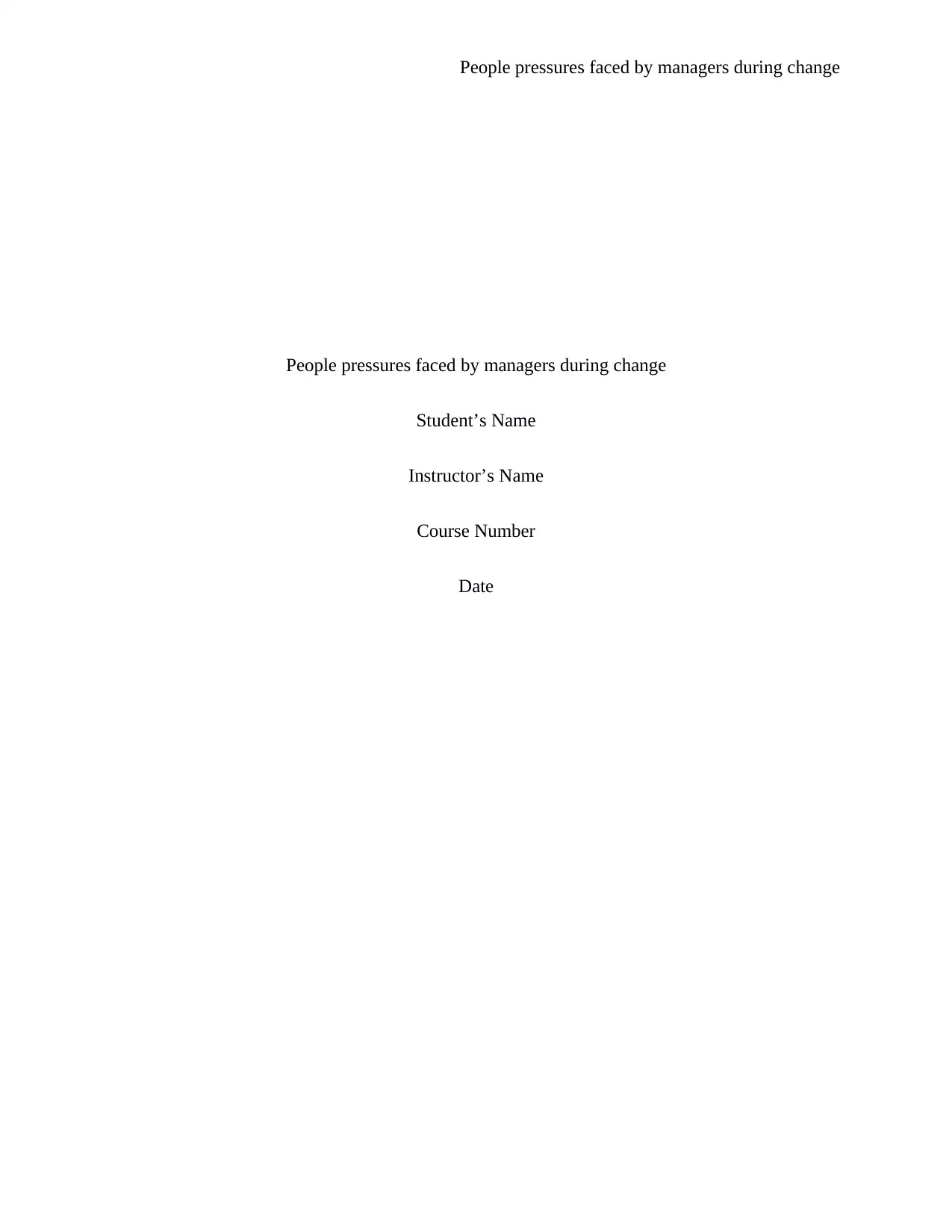
People pressures faced by managers during change
People pressures faced by managers during change
Student’s Name
Instructor’s Name
Course Number
Date
People pressures faced by managers during change
Student’s Name
Instructor’s Name
Course Number
Date
Paraphrase This Document
Need a fresh take? Get an instant paraphrase of this document with our AI Paraphraser
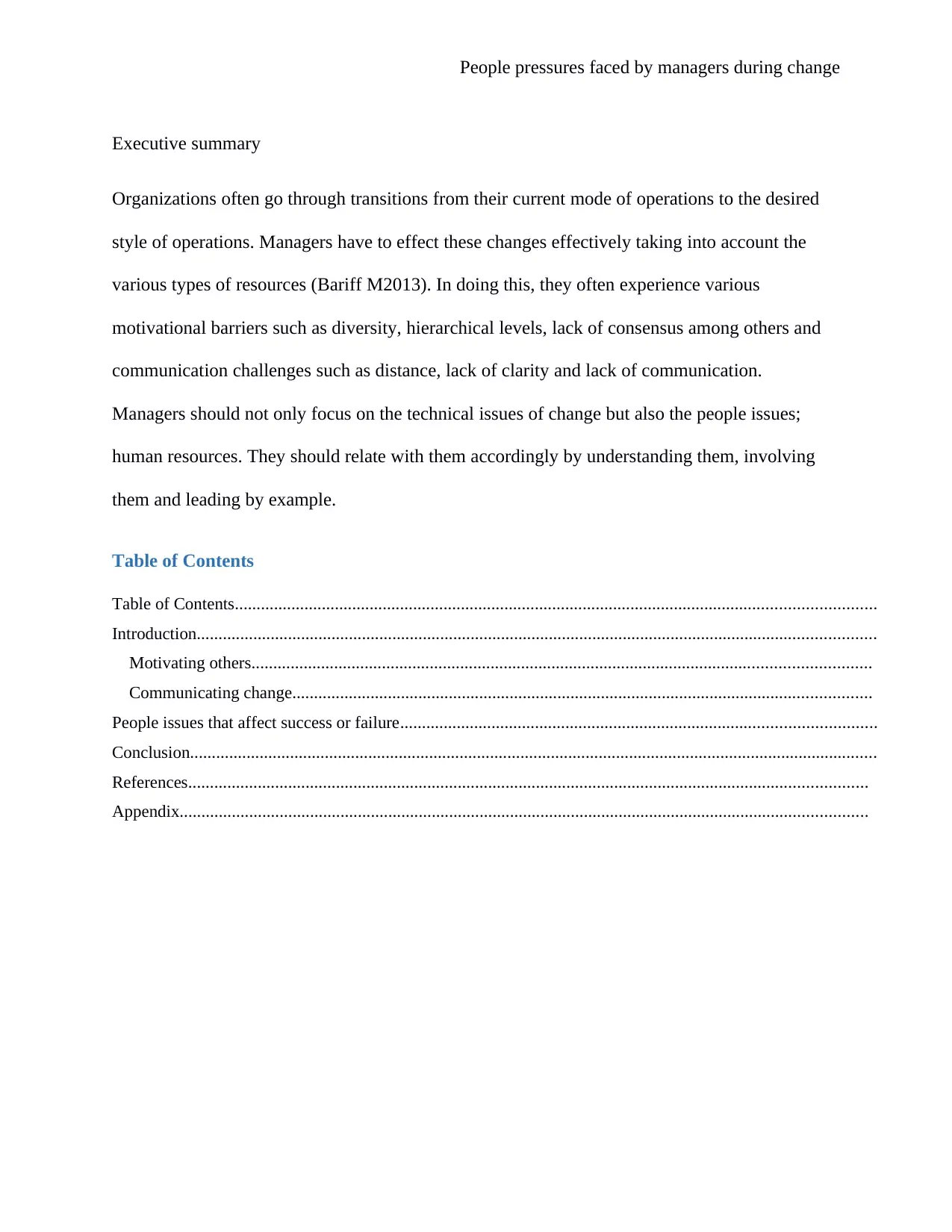
People pressures faced by managers during change
Executive summary
Organizations often go through transitions from their current mode of operations to the desired
style of operations. Managers have to effect these changes effectively taking into account the
various types of resources (Bariff M2013). In doing this, they often experience various
motivational barriers such as diversity, hierarchical levels, lack of consensus among others and
communication challenges such as distance, lack of clarity and lack of communication.
Managers should not only focus on the technical issues of change but also the people issues;
human resources. They should relate with them accordingly by understanding them, involving
them and leading by example.
Table of Contents
Table of Contents...................................................................................................................................................
Introduction............................................................................................................................................................
Motivating others..............................................................................................................................................
Communicating change.....................................................................................................................................
People issues that affect success or failure.............................................................................................................
Conclusion..............................................................................................................................................................
References............................................................................................................................................................
Appendix..............................................................................................................................................................
Executive summary
Organizations often go through transitions from their current mode of operations to the desired
style of operations. Managers have to effect these changes effectively taking into account the
various types of resources (Bariff M2013). In doing this, they often experience various
motivational barriers such as diversity, hierarchical levels, lack of consensus among others and
communication challenges such as distance, lack of clarity and lack of communication.
Managers should not only focus on the technical issues of change but also the people issues;
human resources. They should relate with them accordingly by understanding them, involving
them and leading by example.
Table of Contents
Table of Contents...................................................................................................................................................
Introduction............................................................................................................................................................
Motivating others..............................................................................................................................................
Communicating change.....................................................................................................................................
People issues that affect success or failure.............................................................................................................
Conclusion..............................................................................................................................................................
References............................................................................................................................................................
Appendix..............................................................................................................................................................
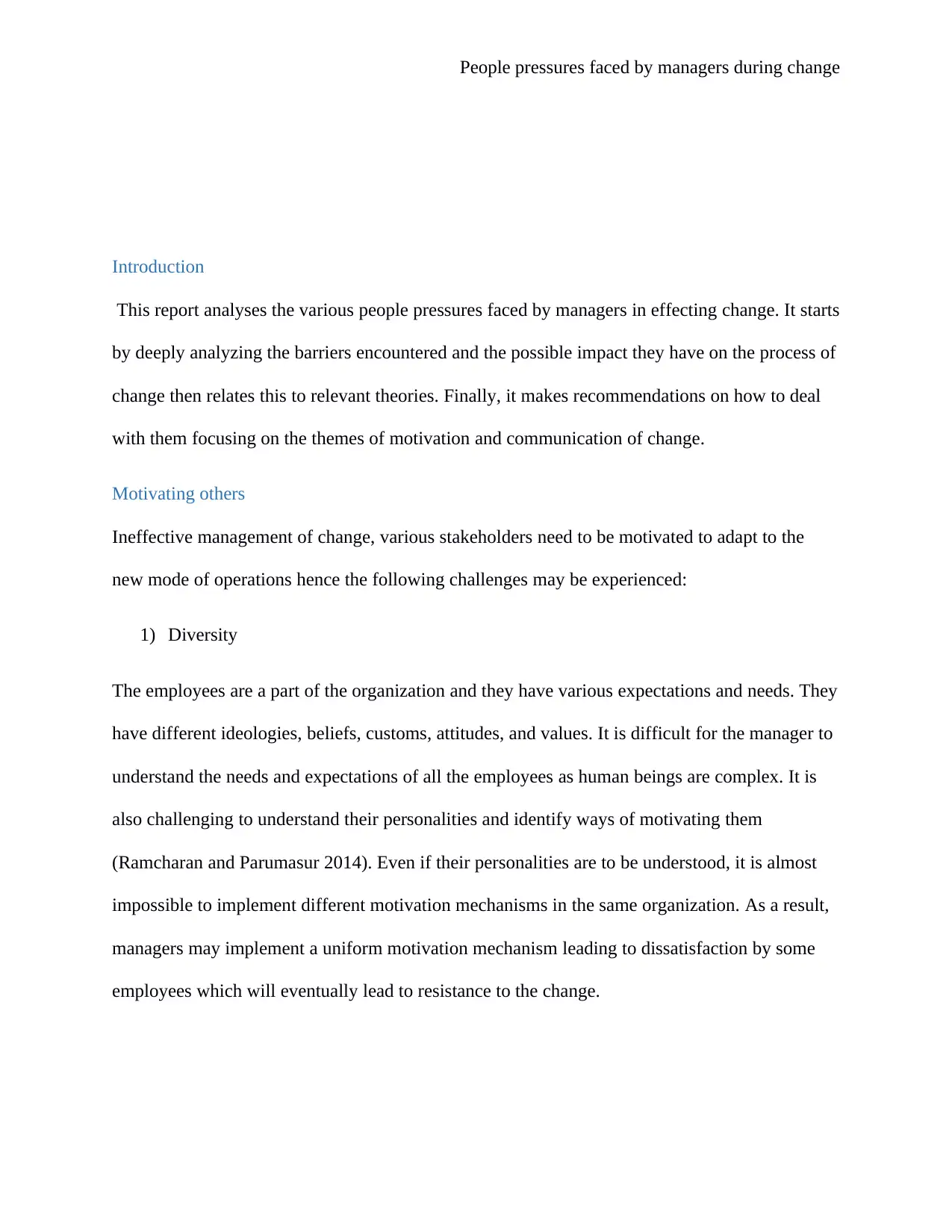
People pressures faced by managers during change
Introduction
This report analyses the various people pressures faced by managers in effecting change. It starts
by deeply analyzing the barriers encountered and the possible impact they have on the process of
change then relates this to relevant theories. Finally, it makes recommendations on how to deal
with them focusing on the themes of motivation and communication of change.
Motivating others
Ineffective management of change, various stakeholders need to be motivated to adapt to the
new mode of operations hence the following challenges may be experienced:
1) Diversity
The employees are a part of the organization and they have various expectations and needs. They
have different ideologies, beliefs, customs, attitudes, and values. It is difficult for the manager to
understand the needs and expectations of all the employees as human beings are complex. It is
also challenging to understand their personalities and identify ways of motivating them
(Ramcharan and Parumasur 2014). Even if their personalities are to be understood, it is almost
impossible to implement different motivation mechanisms in the same organization. As a result,
managers may implement a uniform motivation mechanism leading to dissatisfaction by some
employees which will eventually lead to resistance to the change.
Introduction
This report analyses the various people pressures faced by managers in effecting change. It starts
by deeply analyzing the barriers encountered and the possible impact they have on the process of
change then relates this to relevant theories. Finally, it makes recommendations on how to deal
with them focusing on the themes of motivation and communication of change.
Motivating others
Ineffective management of change, various stakeholders need to be motivated to adapt to the
new mode of operations hence the following challenges may be experienced:
1) Diversity
The employees are a part of the organization and they have various expectations and needs. They
have different ideologies, beliefs, customs, attitudes, and values. It is difficult for the manager to
understand the needs and expectations of all the employees as human beings are complex. It is
also challenging to understand their personalities and identify ways of motivating them
(Ramcharan and Parumasur 2014). Even if their personalities are to be understood, it is almost
impossible to implement different motivation mechanisms in the same organization. As a result,
managers may implement a uniform motivation mechanism leading to dissatisfaction by some
employees which will eventually lead to resistance to the change.
⊘ This is a preview!⊘
Do you want full access?
Subscribe today to unlock all pages.

Trusted by 1+ million students worldwide
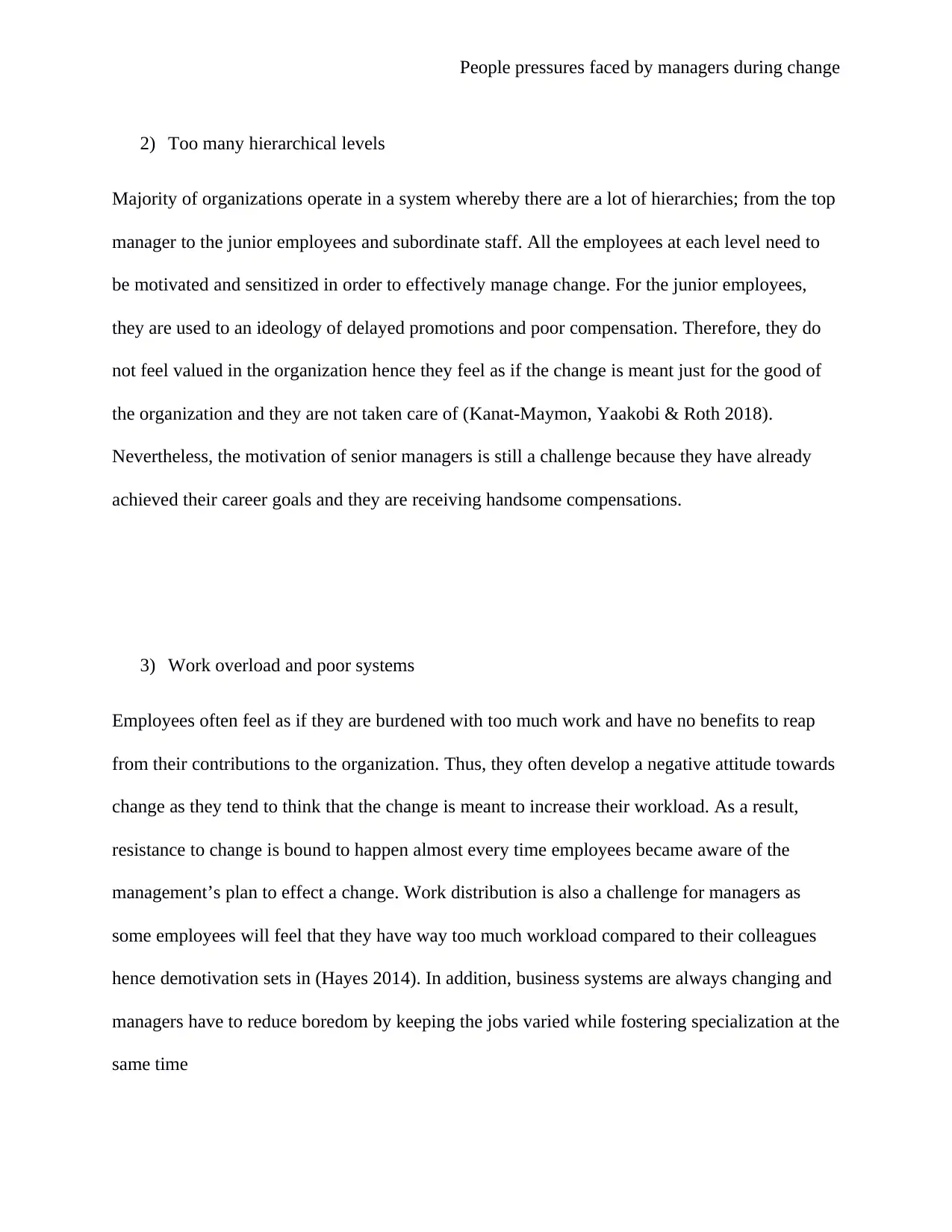
People pressures faced by managers during change
2) Too many hierarchical levels
Majority of organizations operate in a system whereby there are a lot of hierarchies; from the top
manager to the junior employees and subordinate staff. All the employees at each level need to
be motivated and sensitized in order to effectively manage change. For the junior employees,
they are used to an ideology of delayed promotions and poor compensation. Therefore, they do
not feel valued in the organization hence they feel as if the change is meant just for the good of
the organization and they are not taken care of (Kanat-Maymon, Yaakobi & Roth 2018).
Nevertheless, the motivation of senior managers is still a challenge because they have already
achieved their career goals and they are receiving handsome compensations.
3) Work overload and poor systems
Employees often feel as if they are burdened with too much work and have no benefits to reap
from their contributions to the organization. Thus, they often develop a negative attitude towards
change as they tend to think that the change is meant to increase their workload. As a result,
resistance to change is bound to happen almost every time employees became aware of the
management’s plan to effect a change. Work distribution is also a challenge for managers as
some employees will feel that they have way too much workload compared to their colleagues
hence demotivation sets in (Hayes 2014). In addition, business systems are always changing and
managers have to reduce boredom by keeping the jobs varied while fostering specialization at the
same time
2) Too many hierarchical levels
Majority of organizations operate in a system whereby there are a lot of hierarchies; from the top
manager to the junior employees and subordinate staff. All the employees at each level need to
be motivated and sensitized in order to effectively manage change. For the junior employees,
they are used to an ideology of delayed promotions and poor compensation. Therefore, they do
not feel valued in the organization hence they feel as if the change is meant just for the good of
the organization and they are not taken care of (Kanat-Maymon, Yaakobi & Roth 2018).
Nevertheless, the motivation of senior managers is still a challenge because they have already
achieved their career goals and they are receiving handsome compensations.
3) Work overload and poor systems
Employees often feel as if they are burdened with too much work and have no benefits to reap
from their contributions to the organization. Thus, they often develop a negative attitude towards
change as they tend to think that the change is meant to increase their workload. As a result,
resistance to change is bound to happen almost every time employees became aware of the
management’s plan to effect a change. Work distribution is also a challenge for managers as
some employees will feel that they have way too much workload compared to their colleagues
hence demotivation sets in (Hayes 2014). In addition, business systems are always changing and
managers have to reduce boredom by keeping the jobs varied while fostering specialization at the
same time
Paraphrase This Document
Need a fresh take? Get an instant paraphrase of this document with our AI Paraphraser
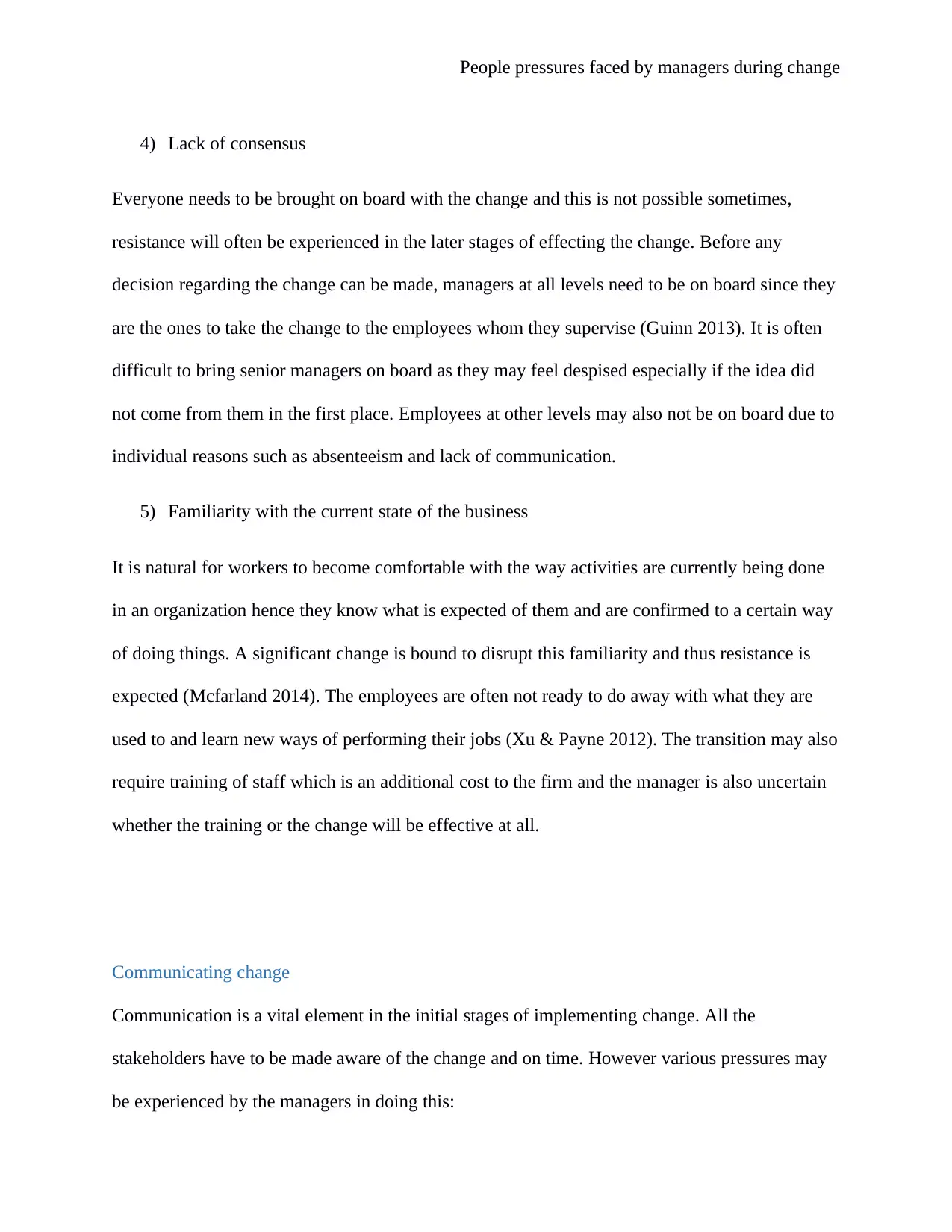
People pressures faced by managers during change
4) Lack of consensus
Everyone needs to be brought on board with the change and this is not possible sometimes,
resistance will often be experienced in the later stages of effecting the change. Before any
decision regarding the change can be made, managers at all levels need to be on board since they
are the ones to take the change to the employees whom they supervise (Guinn 2013). It is often
difficult to bring senior managers on board as they may feel despised especially if the idea did
not come from them in the first place. Employees at other levels may also not be on board due to
individual reasons such as absenteeism and lack of communication.
5) Familiarity with the current state of the business
It is natural for workers to become comfortable with the way activities are currently being done
in an organization hence they know what is expected of them and are confirmed to a certain way
of doing things. A significant change is bound to disrupt this familiarity and thus resistance is
expected (Mcfarland 2014). The employees are often not ready to do away with what they are
used to and learn new ways of performing their jobs (Xu & Payne 2012). The transition may also
require training of staff which is an additional cost to the firm and the manager is also uncertain
whether the training or the change will be effective at all.
Communicating change
Communication is a vital element in the initial stages of implementing change. All the
stakeholders have to be made aware of the change and on time. However various pressures may
be experienced by the managers in doing this:
4) Lack of consensus
Everyone needs to be brought on board with the change and this is not possible sometimes,
resistance will often be experienced in the later stages of effecting the change. Before any
decision regarding the change can be made, managers at all levels need to be on board since they
are the ones to take the change to the employees whom they supervise (Guinn 2013). It is often
difficult to bring senior managers on board as they may feel despised especially if the idea did
not come from them in the first place. Employees at other levels may also not be on board due to
individual reasons such as absenteeism and lack of communication.
5) Familiarity with the current state of the business
It is natural for workers to become comfortable with the way activities are currently being done
in an organization hence they know what is expected of them and are confirmed to a certain way
of doing things. A significant change is bound to disrupt this familiarity and thus resistance is
expected (Mcfarland 2014). The employees are often not ready to do away with what they are
used to and learn new ways of performing their jobs (Xu & Payne 2012). The transition may also
require training of staff which is an additional cost to the firm and the manager is also uncertain
whether the training or the change will be effective at all.
Communicating change
Communication is a vital element in the initial stages of implementing change. All the
stakeholders have to be made aware of the change and on time. However various pressures may
be experienced by the managers in doing this:
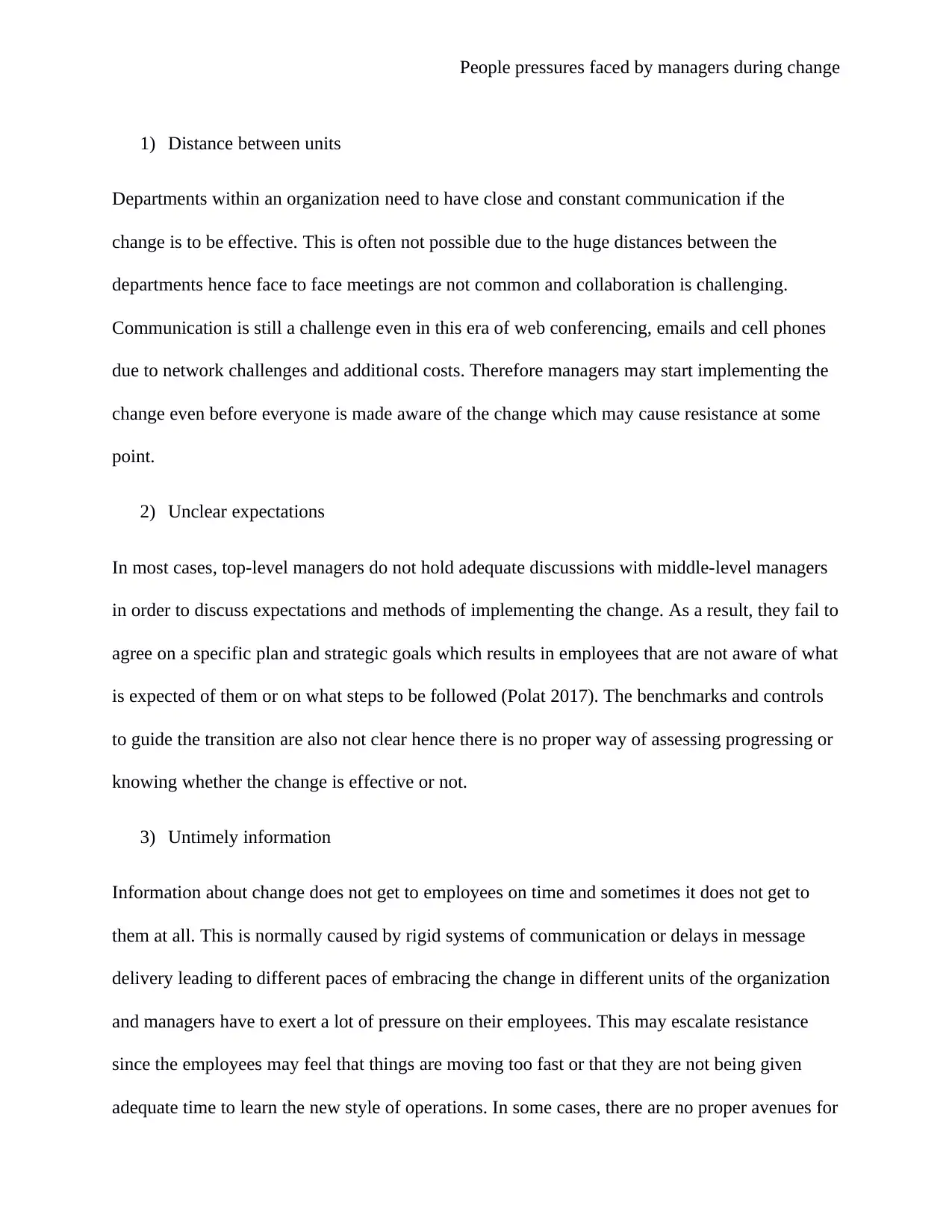
People pressures faced by managers during change
1) Distance between units
Departments within an organization need to have close and constant communication if the
change is to be effective. This is often not possible due to the huge distances between the
departments hence face to face meetings are not common and collaboration is challenging.
Communication is still a challenge even in this era of web conferencing, emails and cell phones
due to network challenges and additional costs. Therefore managers may start implementing the
change even before everyone is made aware of the change which may cause resistance at some
point.
2) Unclear expectations
In most cases, top-level managers do not hold adequate discussions with middle-level managers
in order to discuss expectations and methods of implementing the change. As a result, they fail to
agree on a specific plan and strategic goals which results in employees that are not aware of what
is expected of them or on what steps to be followed (Polat 2017). The benchmarks and controls
to guide the transition are also not clear hence there is no proper way of assessing progressing or
knowing whether the change is effective or not.
3) Untimely information
Information about change does not get to employees on time and sometimes it does not get to
them at all. This is normally caused by rigid systems of communication or delays in message
delivery leading to different paces of embracing the change in different units of the organization
and managers have to exert a lot of pressure on their employees. This may escalate resistance
since the employees may feel that things are moving too fast or that they are not being given
adequate time to learn the new style of operations. In some cases, there are no proper avenues for
1) Distance between units
Departments within an organization need to have close and constant communication if the
change is to be effective. This is often not possible due to the huge distances between the
departments hence face to face meetings are not common and collaboration is challenging.
Communication is still a challenge even in this era of web conferencing, emails and cell phones
due to network challenges and additional costs. Therefore managers may start implementing the
change even before everyone is made aware of the change which may cause resistance at some
point.
2) Unclear expectations
In most cases, top-level managers do not hold adequate discussions with middle-level managers
in order to discuss expectations and methods of implementing the change. As a result, they fail to
agree on a specific plan and strategic goals which results in employees that are not aware of what
is expected of them or on what steps to be followed (Polat 2017). The benchmarks and controls
to guide the transition are also not clear hence there is no proper way of assessing progressing or
knowing whether the change is effective or not.
3) Untimely information
Information about change does not get to employees on time and sometimes it does not get to
them at all. This is normally caused by rigid systems of communication or delays in message
delivery leading to different paces of embracing the change in different units of the organization
and managers have to exert a lot of pressure on their employees. This may escalate resistance
since the employees may feel that things are moving too fast or that they are not being given
adequate time to learn the new style of operations. In some cases, there are no proper avenues for
⊘ This is a preview!⊘
Do you want full access?
Subscribe today to unlock all pages.

Trusted by 1+ million students worldwide
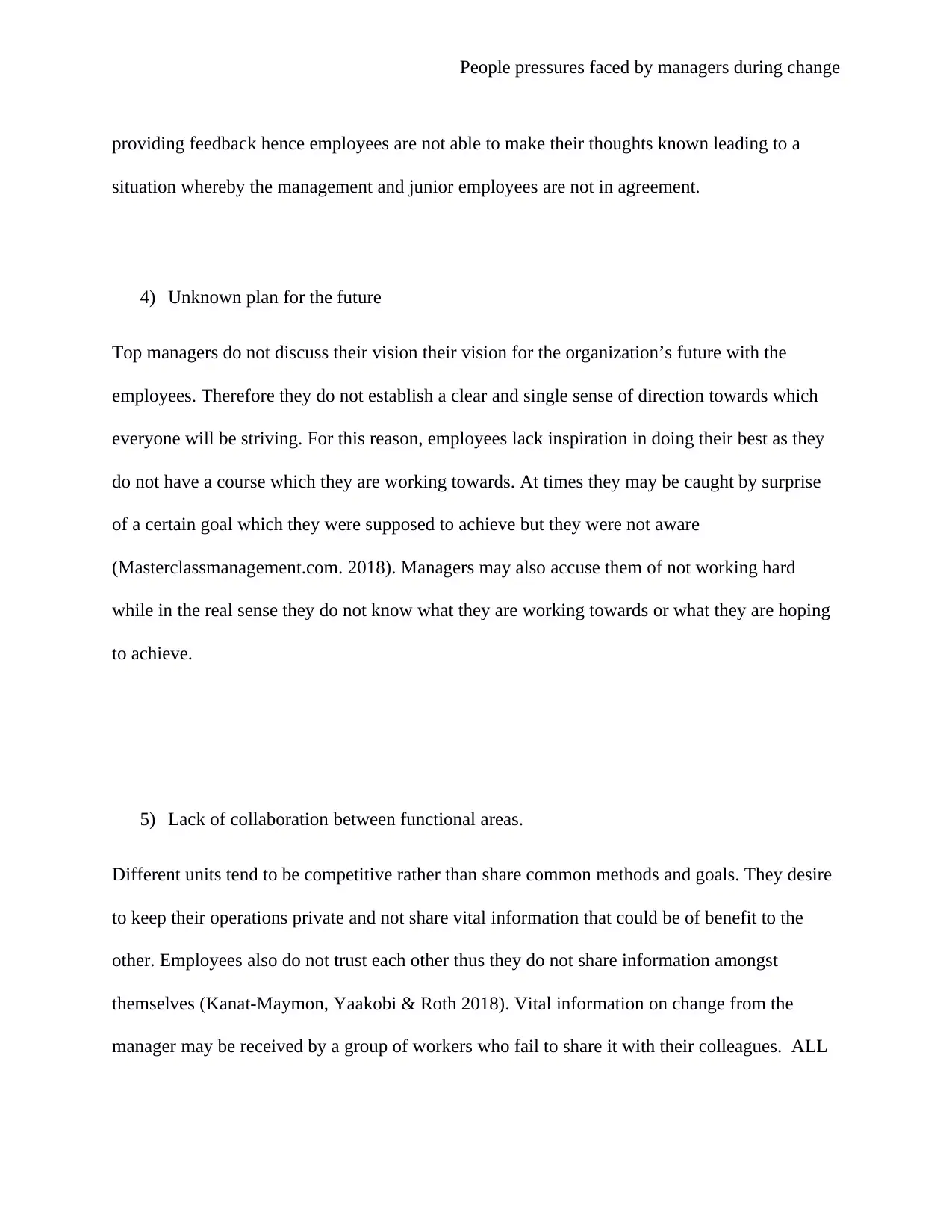
People pressures faced by managers during change
providing feedback hence employees are not able to make their thoughts known leading to a
situation whereby the management and junior employees are not in agreement.
4) Unknown plan for the future
Top managers do not discuss their vision their vision for the organization’s future with the
employees. Therefore they do not establish a clear and single sense of direction towards which
everyone will be striving. For this reason, employees lack inspiration in doing their best as they
do not have a course which they are working towards. At times they may be caught by surprise
of a certain goal which they were supposed to achieve but they were not aware
(Masterclassmanagement.com. 2018). Managers may also accuse them of not working hard
while in the real sense they do not know what they are working towards or what they are hoping
to achieve.
5) Lack of collaboration between functional areas.
Different units tend to be competitive rather than share common methods and goals. They desire
to keep their operations private and not share vital information that could be of benefit to the
other. Employees also do not trust each other thus they do not share information amongst
themselves (Kanat-Maymon, Yaakobi & Roth 2018). Vital information on change from the
manager may be received by a group of workers who fail to share it with their colleagues. ALL
providing feedback hence employees are not able to make their thoughts known leading to a
situation whereby the management and junior employees are not in agreement.
4) Unknown plan for the future
Top managers do not discuss their vision their vision for the organization’s future with the
employees. Therefore they do not establish a clear and single sense of direction towards which
everyone will be striving. For this reason, employees lack inspiration in doing their best as they
do not have a course which they are working towards. At times they may be caught by surprise
of a certain goal which they were supposed to achieve but they were not aware
(Masterclassmanagement.com. 2018). Managers may also accuse them of not working hard
while in the real sense they do not know what they are working towards or what they are hoping
to achieve.
5) Lack of collaboration between functional areas.
Different units tend to be competitive rather than share common methods and goals. They desire
to keep their operations private and not share vital information that could be of benefit to the
other. Employees also do not trust each other thus they do not share information amongst
themselves (Kanat-Maymon, Yaakobi & Roth 2018). Vital information on change from the
manager may be received by a group of workers who fail to share it with their colleagues. ALL
Paraphrase This Document
Need a fresh take? Get an instant paraphrase of this document with our AI Paraphraser
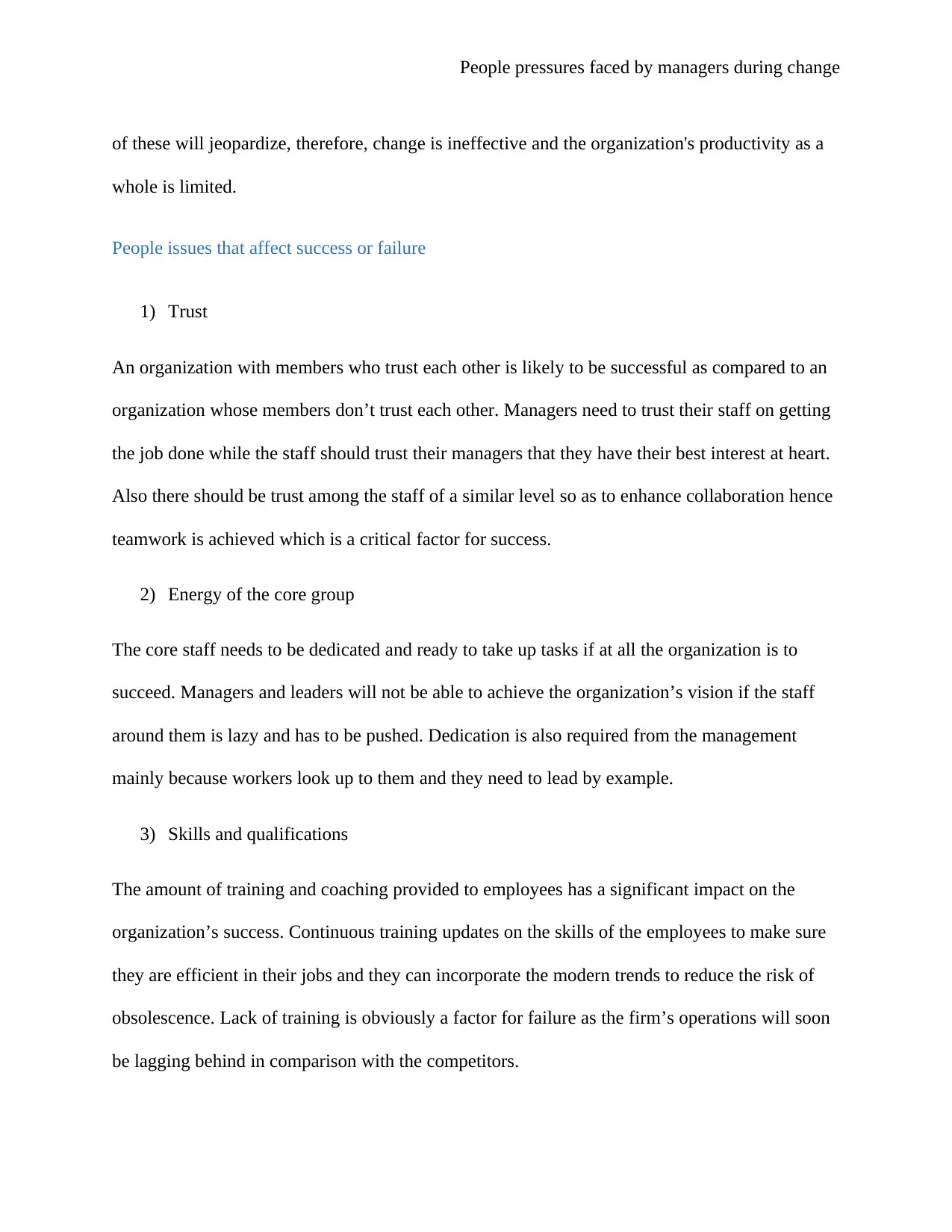
People pressures faced by managers during change
of these will jeopardize, therefore, change is ineffective and the organization's productivity as a
whole is limited.
People issues that affect success or failure
1) Trust
An organization with members who trust each other is likely to be successful as compared to an
organization whose members don’t trust each other. Managers need to trust their staff on getting
the job done while the staff should trust their managers that they have their best interest at heart.
Also there should be trust among the staff of a similar level so as to enhance collaboration hence
teamwork is achieved which is a critical factor for success.
2) Energy of the core group
The core staff needs to be dedicated and ready to take up tasks if at all the organization is to
succeed. Managers and leaders will not be able to achieve the organization’s vision if the staff
around them is lazy and has to be pushed. Dedication is also required from the management
mainly because workers look up to them and they need to lead by example.
3) Skills and qualifications
The amount of training and coaching provided to employees has a significant impact on the
organization’s success. Continuous training updates on the skills of the employees to make sure
they are efficient in their jobs and they can incorporate the modern trends to reduce the risk of
obsolescence. Lack of training is obviously a factor for failure as the firm’s operations will soon
be lagging behind in comparison with the competitors.
of these will jeopardize, therefore, change is ineffective and the organization's productivity as a
whole is limited.
People issues that affect success or failure
1) Trust
An organization with members who trust each other is likely to be successful as compared to an
organization whose members don’t trust each other. Managers need to trust their staff on getting
the job done while the staff should trust their managers that they have their best interest at heart.
Also there should be trust among the staff of a similar level so as to enhance collaboration hence
teamwork is achieved which is a critical factor for success.
2) Energy of the core group
The core staff needs to be dedicated and ready to take up tasks if at all the organization is to
succeed. Managers and leaders will not be able to achieve the organization’s vision if the staff
around them is lazy and has to be pushed. Dedication is also required from the management
mainly because workers look up to them and they need to lead by example.
3) Skills and qualifications
The amount of training and coaching provided to employees has a significant impact on the
organization’s success. Continuous training updates on the skills of the employees to make sure
they are efficient in their jobs and they can incorporate the modern trends to reduce the risk of
obsolescence. Lack of training is obviously a factor for failure as the firm’s operations will soon
be lagging behind in comparison with the competitors.
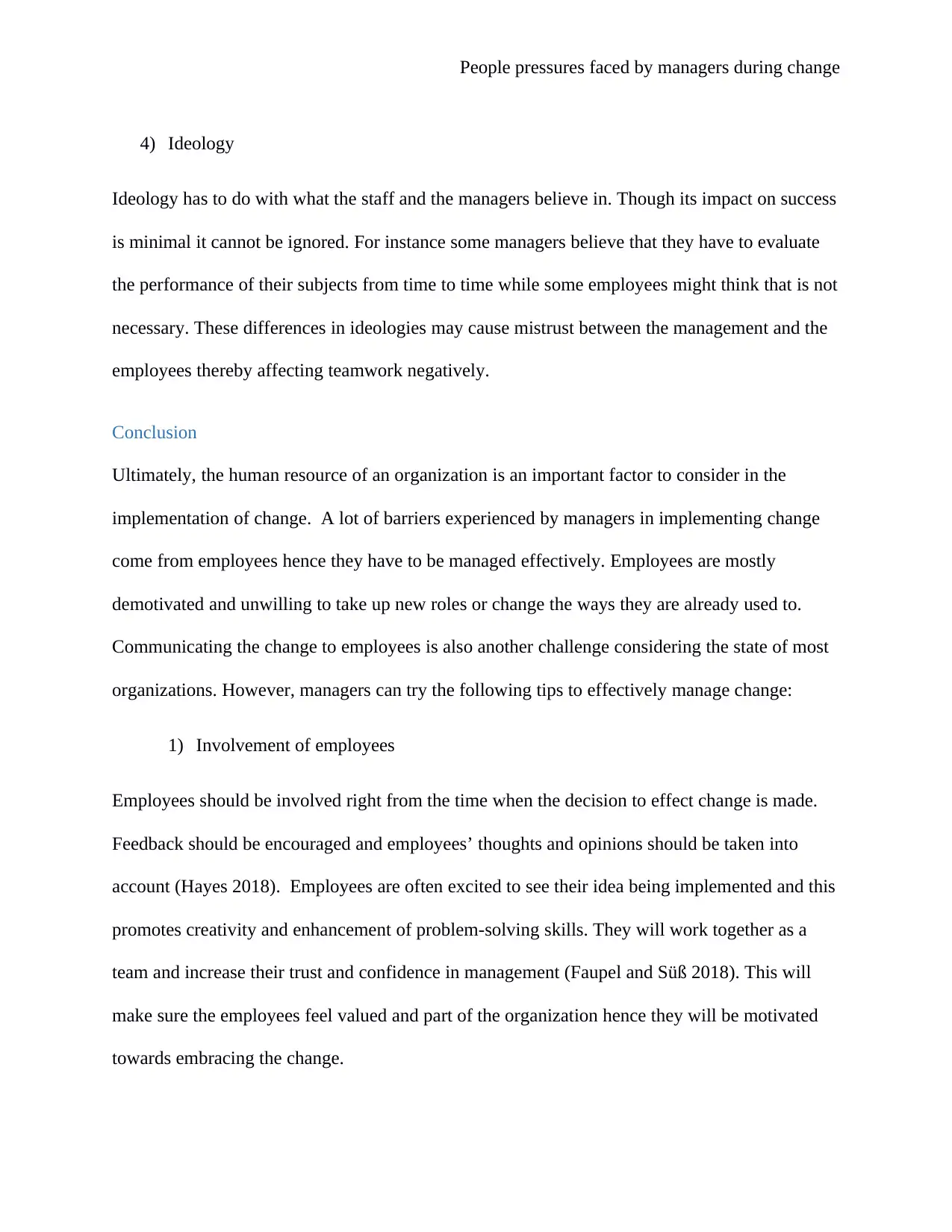
People pressures faced by managers during change
4) Ideology
Ideology has to do with what the staff and the managers believe in. Though its impact on success
is minimal it cannot be ignored. For instance some managers believe that they have to evaluate
the performance of their subjects from time to time while some employees might think that is not
necessary. These differences in ideologies may cause mistrust between the management and the
employees thereby affecting teamwork negatively.
Conclusion
Ultimately, the human resource of an organization is an important factor to consider in the
implementation of change. A lot of barriers experienced by managers in implementing change
come from employees hence they have to be managed effectively. Employees are mostly
demotivated and unwilling to take up new roles or change the ways they are already used to.
Communicating the change to employees is also another challenge considering the state of most
organizations. However, managers can try the following tips to effectively manage change:
1) Involvement of employees
Employees should be involved right from the time when the decision to effect change is made.
Feedback should be encouraged and employees’ thoughts and opinions should be taken into
account (Hayes 2018). Employees are often excited to see their idea being implemented and this
promotes creativity and enhancement of problem-solving skills. They will work together as a
team and increase their trust and confidence in management (Faupel and Süß 2018). This will
make sure the employees feel valued and part of the organization hence they will be motivated
towards embracing the change.
4) Ideology
Ideology has to do with what the staff and the managers believe in. Though its impact on success
is minimal it cannot be ignored. For instance some managers believe that they have to evaluate
the performance of their subjects from time to time while some employees might think that is not
necessary. These differences in ideologies may cause mistrust between the management and the
employees thereby affecting teamwork negatively.
Conclusion
Ultimately, the human resource of an organization is an important factor to consider in the
implementation of change. A lot of barriers experienced by managers in implementing change
come from employees hence they have to be managed effectively. Employees are mostly
demotivated and unwilling to take up new roles or change the ways they are already used to.
Communicating the change to employees is also another challenge considering the state of most
organizations. However, managers can try the following tips to effectively manage change:
1) Involvement of employees
Employees should be involved right from the time when the decision to effect change is made.
Feedback should be encouraged and employees’ thoughts and opinions should be taken into
account (Hayes 2018). Employees are often excited to see their idea being implemented and this
promotes creativity and enhancement of problem-solving skills. They will work together as a
team and increase their trust and confidence in management (Faupel and Süß 2018). This will
make sure the employees feel valued and part of the organization hence they will be motivated
towards embracing the change.
⊘ This is a preview!⊘
Do you want full access?
Subscribe today to unlock all pages.

Trusted by 1+ million students worldwide
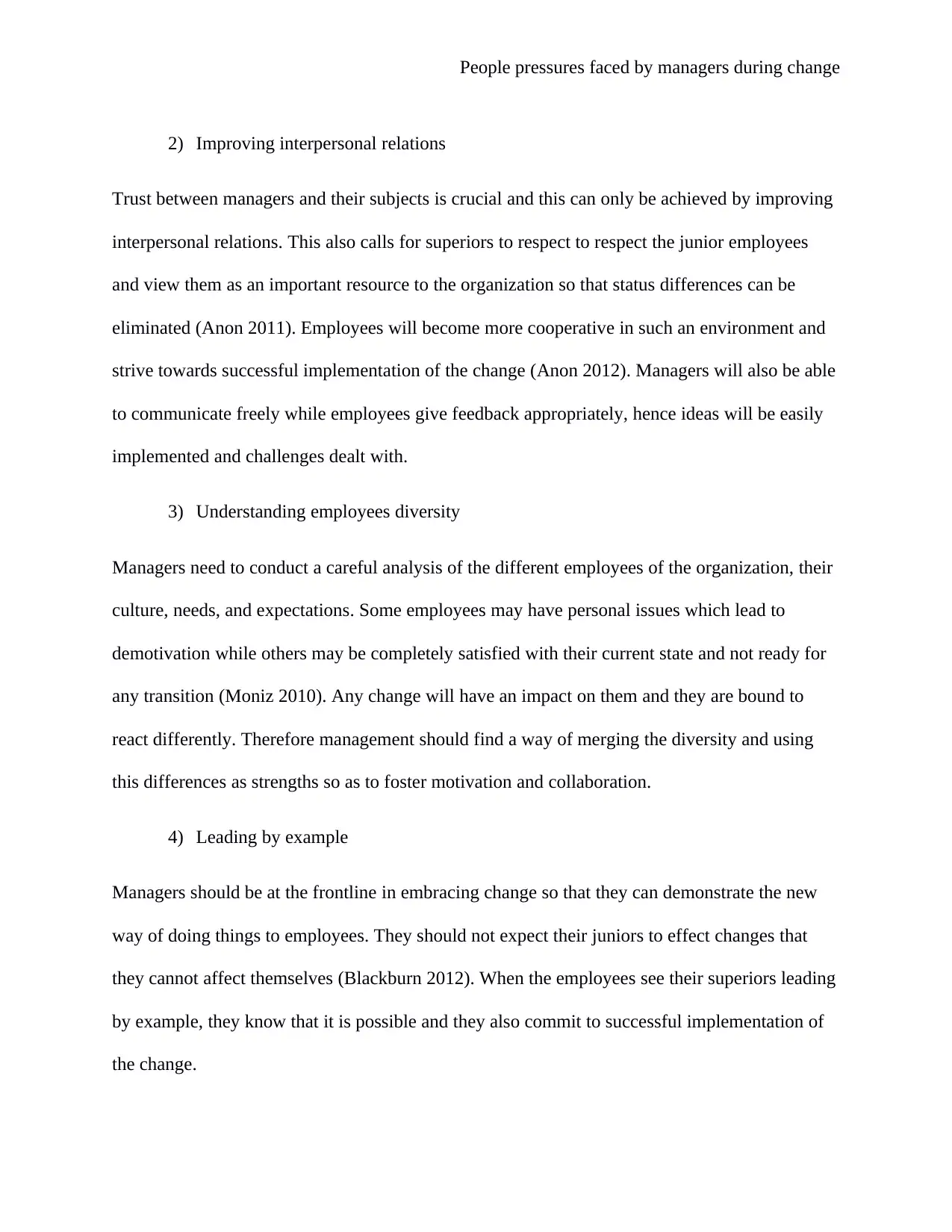
People pressures faced by managers during change
2) Improving interpersonal relations
Trust between managers and their subjects is crucial and this can only be achieved by improving
interpersonal relations. This also calls for superiors to respect to respect the junior employees
and view them as an important resource to the organization so that status differences can be
eliminated (Anon 2011). Employees will become more cooperative in such an environment and
strive towards successful implementation of the change (Anon 2012). Managers will also be able
to communicate freely while employees give feedback appropriately, hence ideas will be easily
implemented and challenges dealt with.
3) Understanding employees diversity
Managers need to conduct a careful analysis of the different employees of the organization, their
culture, needs, and expectations. Some employees may have personal issues which lead to
demotivation while others may be completely satisfied with their current state and not ready for
any transition (Moniz 2010). Any change will have an impact on them and they are bound to
react differently. Therefore management should find a way of merging the diversity and using
this differences as strengths so as to foster motivation and collaboration.
4) Leading by example
Managers should be at the frontline in embracing change so that they can demonstrate the new
way of doing things to employees. They should not expect their juniors to effect changes that
they cannot affect themselves (Blackburn 2012). When the employees see their superiors leading
by example, they know that it is possible and they also commit to successful implementation of
the change.
2) Improving interpersonal relations
Trust between managers and their subjects is crucial and this can only be achieved by improving
interpersonal relations. This also calls for superiors to respect to respect the junior employees
and view them as an important resource to the organization so that status differences can be
eliminated (Anon 2011). Employees will become more cooperative in such an environment and
strive towards successful implementation of the change (Anon 2012). Managers will also be able
to communicate freely while employees give feedback appropriately, hence ideas will be easily
implemented and challenges dealt with.
3) Understanding employees diversity
Managers need to conduct a careful analysis of the different employees of the organization, their
culture, needs, and expectations. Some employees may have personal issues which lead to
demotivation while others may be completely satisfied with their current state and not ready for
any transition (Moniz 2010). Any change will have an impact on them and they are bound to
react differently. Therefore management should find a way of merging the diversity and using
this differences as strengths so as to foster motivation and collaboration.
4) Leading by example
Managers should be at the frontline in embracing change so that they can demonstrate the new
way of doing things to employees. They should not expect their juniors to effect changes that
they cannot affect themselves (Blackburn 2012). When the employees see their superiors leading
by example, they know that it is possible and they also commit to successful implementation of
the change.
Paraphrase This Document
Need a fresh take? Get an instant paraphrase of this document with our AI Paraphraser
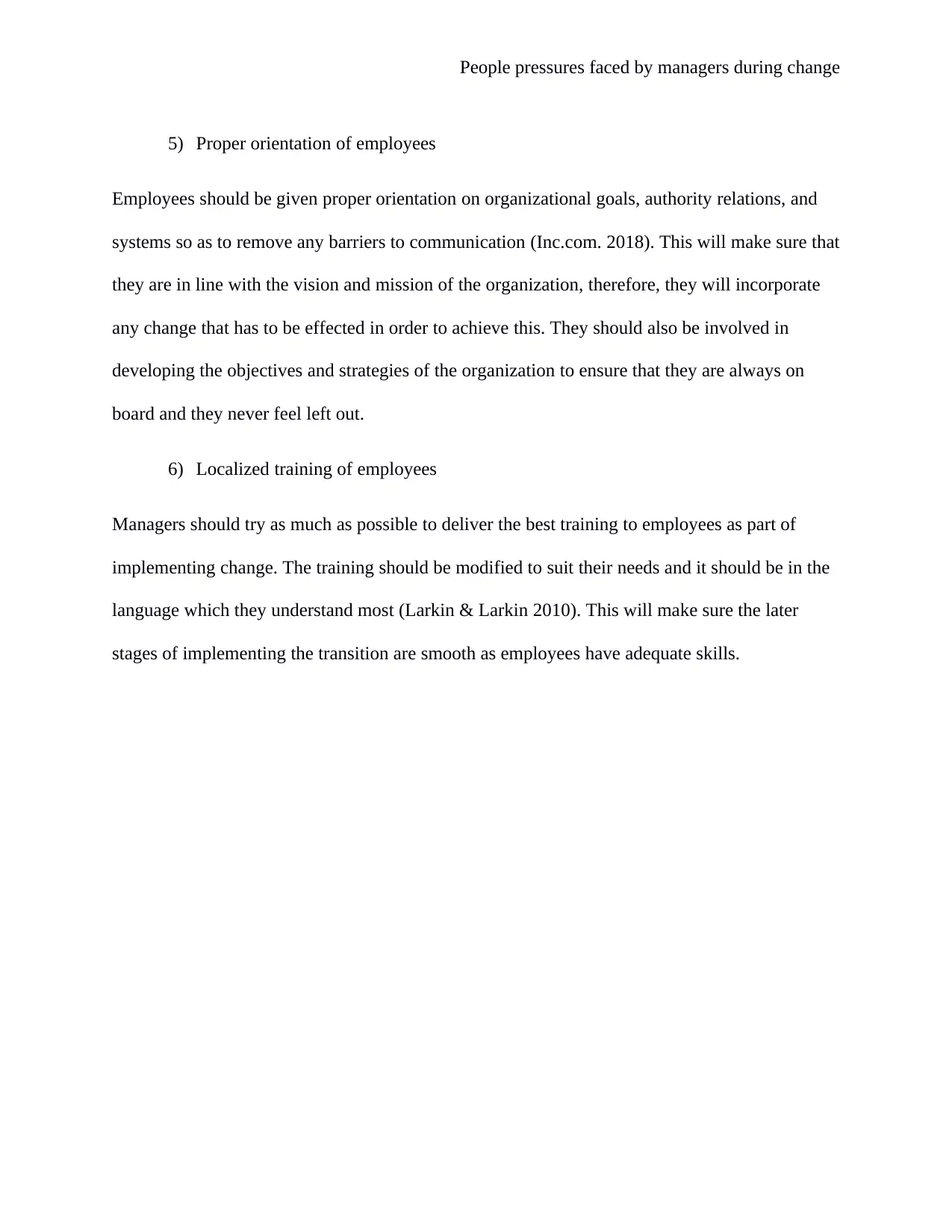
People pressures faced by managers during change
5) Proper orientation of employees
Employees should be given proper orientation on organizational goals, authority relations, and
systems so as to remove any barriers to communication (Inc.com. 2018). This will make sure that
they are in line with the vision and mission of the organization, therefore, they will incorporate
any change that has to be effected in order to achieve this. They should also be involved in
developing the objectives and strategies of the organization to ensure that they are always on
board and they never feel left out.
6) Localized training of employees
Managers should try as much as possible to deliver the best training to employees as part of
implementing change. The training should be modified to suit their needs and it should be in the
language which they understand most (Larkin & Larkin 2010). This will make sure the later
stages of implementing the transition are smooth as employees have adequate skills.
5) Proper orientation of employees
Employees should be given proper orientation on organizational goals, authority relations, and
systems so as to remove any barriers to communication (Inc.com. 2018). This will make sure that
they are in line with the vision and mission of the organization, therefore, they will incorporate
any change that has to be effected in order to achieve this. They should also be involved in
developing the objectives and strategies of the organization to ensure that they are always on
board and they never feel left out.
6) Localized training of employees
Managers should try as much as possible to deliver the best training to employees as part of
implementing change. The training should be modified to suit their needs and it should be in the
language which they understand most (Larkin & Larkin 2010). This will make sure the later
stages of implementing the transition are smooth as employees have adequate skills.
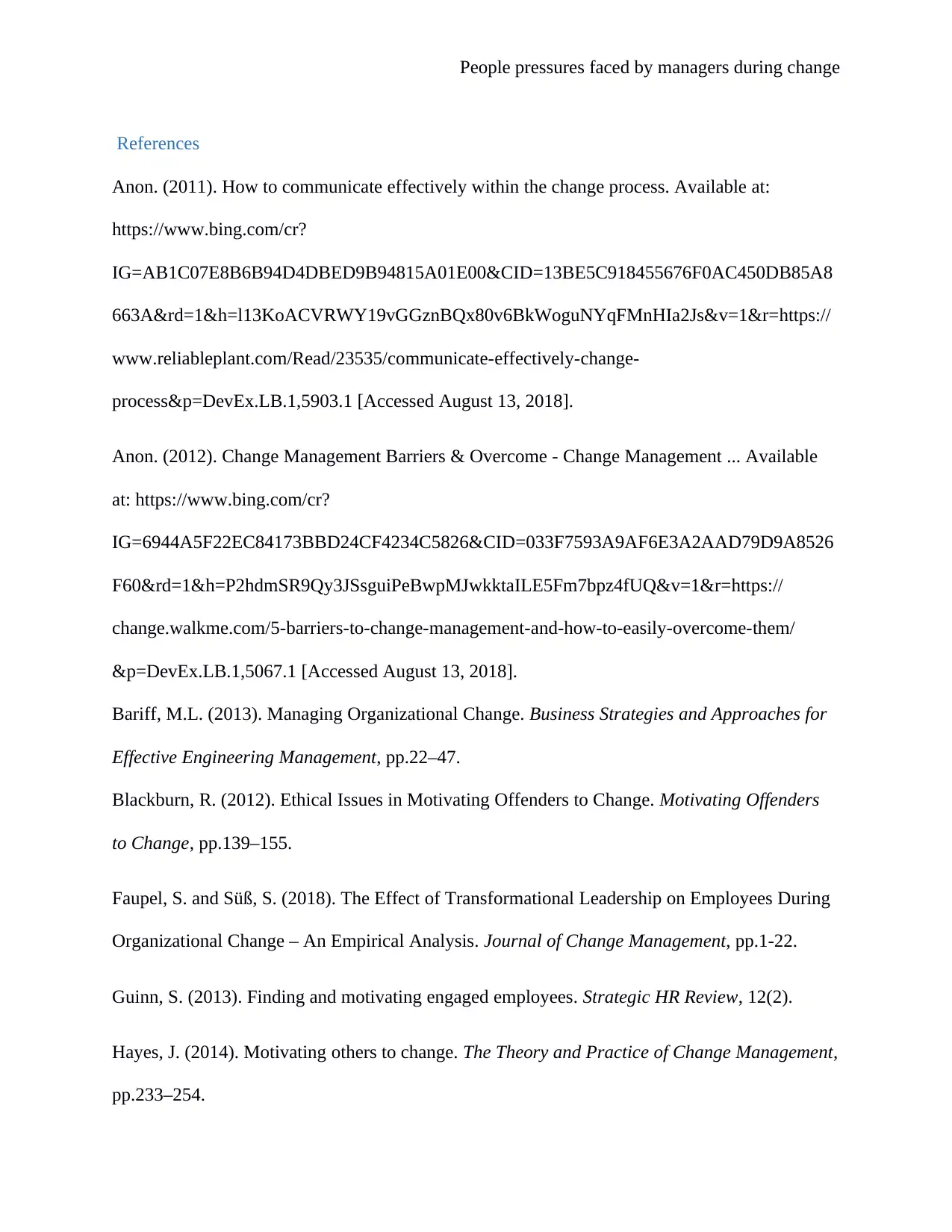
People pressures faced by managers during change
References
Anon. (2011). How to communicate effectively within the change process. Available at:
https://www.bing.com/cr?
IG=AB1C07E8B6B94D4DBED9B94815A01E00&CID=13BE5C918455676F0AC450DB85A8
663A&rd=1&h=l13KoACVRWY19vGGznBQx80v6BkWoguNYqFMnHIa2Js&v=1&r=https://
www.reliableplant.com/Read/23535/communicate-effectively-change-
process&p=DevEx.LB.1,5903.1 [Accessed August 13, 2018].
Anon. (2012). Change Management Barriers & Overcome - Change Management ... Available
at: https://www.bing.com/cr?
IG=6944A5F22EC84173BBD24CF4234C5826&CID=033F7593A9AF6E3A2AAD79D9A8526
F60&rd=1&h=P2hdmSR9Qy3JSsguiPeBwpMJwkktaILE5Fm7bpz4fUQ&v=1&r=https://
change.walkme.com/5-barriers-to-change-management-and-how-to-easily-overcome-them/
&p=DevEx.LB.1,5067.1 [Accessed August 13, 2018].
Bariff, M.L. (2013). Managing Organizational Change. Business Strategies and Approaches for
Effective Engineering Management, pp.22–47.
Blackburn, R. (2012). Ethical Issues in Motivating Offenders to Change. Motivating Offenders
to Change, pp.139–155.
Faupel, S. and Süß, S. (2018). The Effect of Transformational Leadership on Employees During
Organizational Change – An Empirical Analysis. Journal of Change Management, pp.1-22.
Guinn, S. (2013). Finding and motivating engaged employees. Strategic HR Review, 12(2).
Hayes, J. (2014). Motivating others to change. The Theory and Practice of Change Management,
pp.233–254.
References
Anon. (2011). How to communicate effectively within the change process. Available at:
https://www.bing.com/cr?
IG=AB1C07E8B6B94D4DBED9B94815A01E00&CID=13BE5C918455676F0AC450DB85A8
663A&rd=1&h=l13KoACVRWY19vGGznBQx80v6BkWoguNYqFMnHIa2Js&v=1&r=https://
www.reliableplant.com/Read/23535/communicate-effectively-change-
process&p=DevEx.LB.1,5903.1 [Accessed August 13, 2018].
Anon. (2012). Change Management Barriers & Overcome - Change Management ... Available
at: https://www.bing.com/cr?
IG=6944A5F22EC84173BBD24CF4234C5826&CID=033F7593A9AF6E3A2AAD79D9A8526
F60&rd=1&h=P2hdmSR9Qy3JSsguiPeBwpMJwkktaILE5Fm7bpz4fUQ&v=1&r=https://
change.walkme.com/5-barriers-to-change-management-and-how-to-easily-overcome-them/
&p=DevEx.LB.1,5067.1 [Accessed August 13, 2018].
Bariff, M.L. (2013). Managing Organizational Change. Business Strategies and Approaches for
Effective Engineering Management, pp.22–47.
Blackburn, R. (2012). Ethical Issues in Motivating Offenders to Change. Motivating Offenders
to Change, pp.139–155.
Faupel, S. and Süß, S. (2018). The Effect of Transformational Leadership on Employees During
Organizational Change – An Empirical Analysis. Journal of Change Management, pp.1-22.
Guinn, S. (2013). Finding and motivating engaged employees. Strategic HR Review, 12(2).
Hayes, J. (2014). Motivating others to change. The Theory and Practice of Change Management,
pp.233–254.
⊘ This is a preview!⊘
Do you want full access?
Subscribe today to unlock all pages.

Trusted by 1+ million students worldwide
1 out of 16
Related Documents
Your All-in-One AI-Powered Toolkit for Academic Success.
+13062052269
info@desklib.com
Available 24*7 on WhatsApp / Email
![[object Object]](/_next/static/media/star-bottom.7253800d.svg)
Unlock your academic potential
Copyright © 2020–2025 A2Z Services. All Rights Reserved. Developed and managed by ZUCOL.





